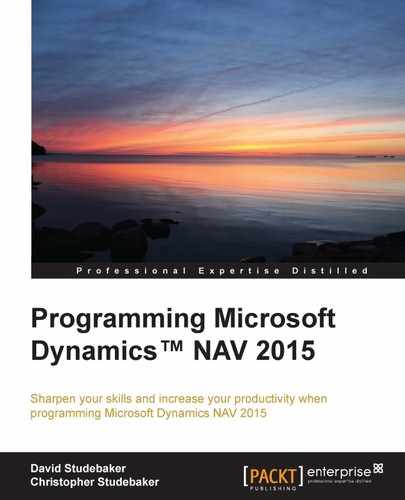Welcome to the worldwide community of Microsoft Dynamics NAV developers. This is a collegial environment populated by C/AL developers who readily and generously share their knowledge. There are formal and informal organizations of NAV-focused users, developers, and vendor firms scattered around the globe and active on the Web. Our community continues to grow and prosper, now including over 110,000 user companies worldwide.
The information in this book will help you to shorten your learning curve of how to program for the NAV 2015 ERP system using the C/AL language, the C/SIDE integrated development environment and their capabilities. We hope you enjoy working with NAV as much as we have.
Each new version of Microsoft Dynamics NAV is the result of inspiration and hard work along with some good fortune and expert technical investment over the last thirty years.
Three college friends, Jesper Balser, Torben Wind, and Peter Bang, from Denmark Technical University (DTU) founded their computer software business in 1984 when they were in their early twenties. This business was Personal Computing & Consulting (PC & C) and its first product was called PC Plus.
PC Plus was released in 1985 with the primary goal of ease of use. An early employee said its functional design was inspired by the combination of a manual ledger journal, an Epson FX 80 printer, and a Canon calculator. Incidentally, Peter Bang is the grandson of one of the founders of Bang & Olufsen, the manufacturer of home entertainment systems par excellence.
PC Plus was a PC DOS-based single user system. PC Plus' design features included these:
- An interface resembling the use of documents and calculators
- Online help
- Good exception handling
- Minimal computer resources required
The PC Plus product was marketed through dealers in Denmark and Norway.
In 1987, PC & C released a new product, the multi-user Navigator and a new corporate name, Navision. Navigator was quite a technological leap forward. It included the following:
- Client/Server technology
- A relational database
- Transaction-based processing
- Version management
- High-speed OLAP capabilities (SIFT technology)
- A screen painter tool
- A programmable report writer
In 1990, Navision was expanding its marketing and dealer recruitment efforts in Germany, Spain, and the United Kingdom. Also in 1990, V3 of Navigator was released. Navigator V3 was still a character-based system, albeit a very sophisticated one. If you get an opportunity to study Navigator V3.x, you would instantly recognize the roots of today's NAV product. By V3, the product included these features:
- A design based on object-oriented concepts
- Integrated 4GL Table, Form, and Report Design tools (the IDE)
- Structured exception handling
- Built-in resource management
- The original programming language that became C/AL
- Function libraries
- The concept of regional or country-based localization
When Navigator V3.5 was released, it also included support for multiple platforms and databases. Navigator V3.5 would run on both Unix and Windows NT networks. It supported the Oracle and Informix databases, as well as the one developed in-house.
Around this time, several major strategic efforts were initiated. On the technical side, the decision was made to develop a GUI-based product. The first prototype of Navision Financials (for Windows) was shown in 1992. At about the same time, a relationship was established that would take Navision into distribution in the United States. The initial release in the US in 1995 was V3.5 of the character-based product, rechristened as Avista for the US distribution.
In 1995, Navision Financials V1.0 for Microsoft Windows was released. This product had many (but not all) of the features of Navigator V3.5. It was designed for complete look-and-feel compatibility with Windows 95. There was an effort to provide the ease of use and flexibility of development of Microsoft Access. The new Navision Financials was very compatible with Microsoft Office and was thus sold as "being familiar to any Office user". Like any V1.0 product, it was quickly followed by a much improved V1.1.
In the next few years, Navision continued to be improved and enhanced. Major new functionalities were added, such as:
- Contact Relation Management (CRM)
- Manufacturing (ERP)
- Advanced Distribution (including Warehouse Management)
Various Microsoft certifications were obtained, providing muscle to the marketing efforts. Geographic and dealer base expansion continued apace. By 2000, according to the Navision Annual Report of that year, the product was represented by nearly 1,000 dealers (Navision Solution Centers) in 24 countries and used by 41,000 customers located in 108 countries.
